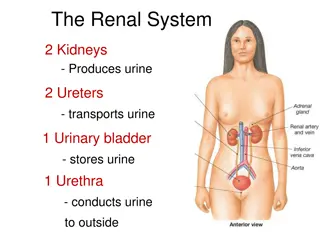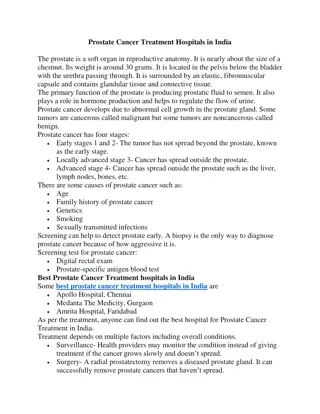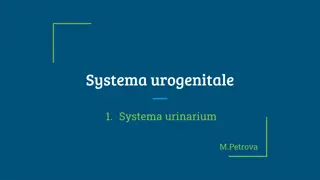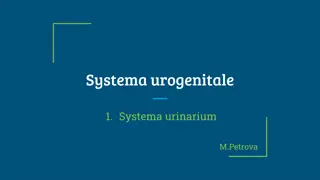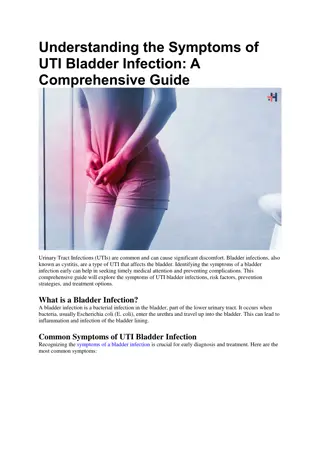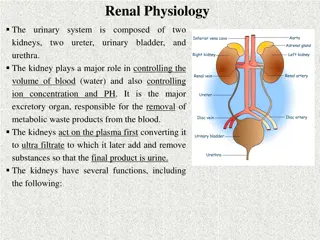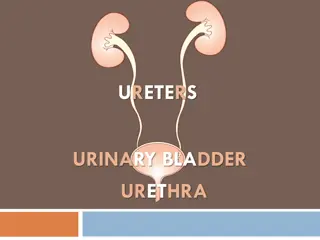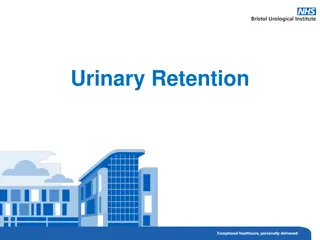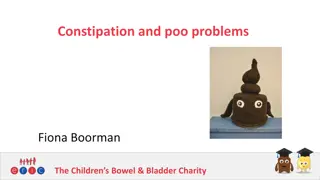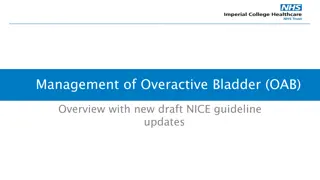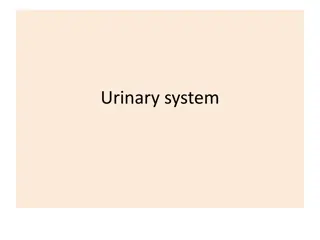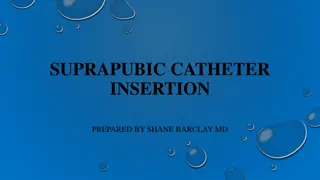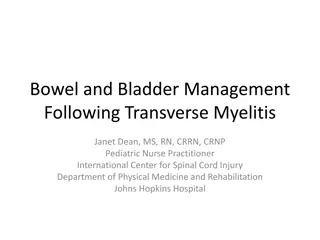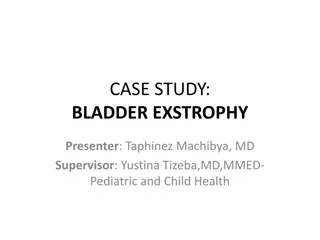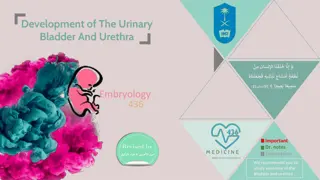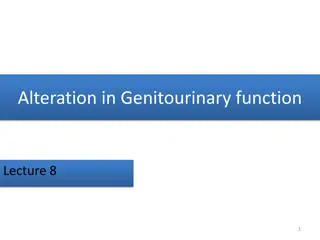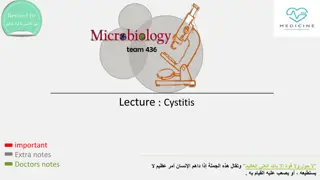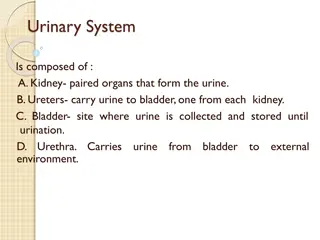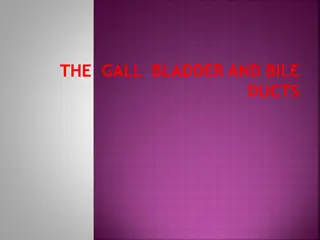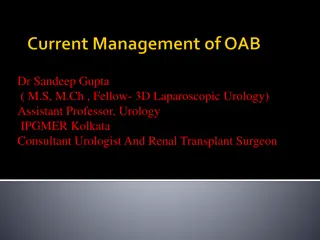Physiology of Micturition
The process of micturition (urination), the functional anatomy of the urinary bladder, neural control, the mechanism of filling and emptying of the bladder, and the neurogenic control of the micturition reflex and its disorders.
15 views • 23 slides
Understanding Urinary Elimination: Anatomy, Physiology, and Function of the Kidneys
The lecture covers the fundamentals of urinary elimination focusing on the kidneys' location, structure, function, and the role of nephrons. It discusses the transport of urine through the ureters to the bladder, highlighting the bladder's muscle layers and the urethra's role in expelling urine. Stu
3 views • 37 slides
An Overview of the Renal System and Nephron Anatomy
The renal system consists of the kidneys, ureters, urinary bladder, and urethra, responsible for producing, transporting, storing, and excreting urine. The kidneys are surrounded by three layers, and the nephron is the functional unit responsible for filtering blood and producing urine. Key componen
4 views • 26 slides
Comprehensive Guide to Continuous Bladder Irrigation (CBI)
Explore the essential information about Continuous Bladder Irrigation (CBI), including its procedure, indications, supplies and equipment needed, documentation guidelines, and monitoring protocols. Learn about the importance of CBI in post-prostate surgery, urinary tract obstruction prevention, clot
5 views • 14 slides
Cancer Specialist in Pune PCMC – Dr. Manoj Dongare
Dr. Manoj Dongare is one of the most experienced and qualified Cancer Specialists in PCMC, Pune with more than 16 years of experience in treating various types of cancers. Also, He has expertise in various cancer surgeries like breast, lung, Gynecological, bladder, oral, and GI cancers. He is one o
5 views • 3 slides
Best Prostate Cancer Treatment Hospitals in India
The prostate is a soft organ in reproductive anatomy. It is nearly about the size of a chestnut. Its weight is around 30 grams. It is located in the pelvis below the bladder with the urethra passing through. It is surrounded by an elastic, fibromuscular capsule and contains glandular tissue and conn
1 views • 2 slides
Understanding the Urinary System: Anatomical Structures and Terms
This informative content delves into the anatomical structures and terms related to the urinary system, covering key components such as the kidneys, ureters, bladder, and urethra. It explains important terms like renal pyramids, calices, and ureter dexter/sinister, providing a comprehensive overview
1 views • 8 slides
Understanding Urinary Incontinence in the Elderly
The urinary system plays a vital role in regulating blood volume, pressure, and waste excretion. Urinary incontinence in the elderly can be caused by weak bladder muscles or neurological issues. The bladder consists of 4 layers, each serving a specific function. Normal voiding frequency and bladder
0 views • 50 slides
Understanding Medications and Pharmacological Therapy for Urinary Incontinence
This learning module for clinicians discusses the physiology of bladder control, age-related changes in the genitourinary system, medications that contribute to urinary incontinence, pharmacological treatments for UI, side effects of medications used for UI, and a senior-friendly approach to optimiz
0 views • 30 slides
Overview of Urinary System Anatomy and General Terminology
This content provides detailed information on the anatomy of the urinary system, including the kidneys, ureters, bladder, and urethra. It explains anatomical terms, Greek term elements related to the system, and general terms for urine and urination. Additionally, it covers urinary dysfunctions such
2 views • 8 slides
Veterinary Anatomy of Urinary System in Different Animals
The urinary system in animals includes kidneys, ureters, and the bladder, all crucial for filtration and urine excretion. The ureters are excretory ducts from the kidneys, while the bladder stores urine before expulsion. Various diagrammatic structures illustrate the urogenital system of animals, pa
0 views • 20 slides
Understanding the Symptoms of UTI Bladder Infection
This comprehensive guide will explore the symptoms of UTI bladder infections, risk factors, prevention strategies, and treatment options.
0 views • 5 slides
Understanding Renal Physiology: The Role of the Kidneys in Maintaining Homeostasis
The urinary system consists of the kidneys, ureters, urinary bladder, and urethra, playing a crucial role in regulating blood volume, ion concentration, and pH. The kidneys, as the major excretory organ, remove metabolic waste products and help maintain water-electrolyte balance, regulate arterial p
0 views • 27 slides
Veterinary Surgical Procedures Overview
Veterinary surgical procedures such as spaying, neutering, exploratory surgeries, bladder stone removal, and surgical fracture repair are essential for maintaining the health and well-being of animals. Exploratory procedures help diagnose issues when other tests fail to reveal abnormalities, and sur
1 views • 31 slides
Understanding the Anatomy of Ureters, Urinary Bladder, and Urethra
Explore the detailed anatomy of ureters, urinary bladder, and urethra in this comprehensive guide. Learn about the course of ureters, important relations of the urinary bladder, and differences in male and female urethra. Discover the sites of ureteric constrictions, arterial blood supply, and more.
0 views • 22 slides
Overview of Bladder Tumours: Causes, Symptoms, and Diagnosis
Bladder tumours, particularly Transitional Cell Carcinoma (TCC), are the second most common cancer in the genitourinary system. Mainly caused by factors like cigarette smoking, industrial toxins, and genetic events, bladder cancer presents with symptoms such as hematuria and irritative voiding sympt
0 views • 26 slides
Understanding Urinary Retention: Causes, Symptoms, and Management
Urinary retention can be acute or chronic, resulting in the painful inability to void or fully empty the bladder. In men, common causes include benign prostatic enlargement and post-surgery complications, while women may experience it due to pelvic prolapse or neurological issues. Initial management
3 views • 13 slides
Understanding Constipation and Poo Problems in Children
This resource provides insightful information on constipation and related issues in children, including causes, symptoms, treatments, and the impact on bowel and bladder health. It covers various topics such as bowel actions, medications, normal bowel function, and the significance of recognizing an
0 views • 21 slides
Gall Bladder Cancers in India: A Report from Population Based Cancer Registries (1982-2010)
This report discusses the incidence rates of gall bladder cancers in various regions worldwide, focusing on India. It highlights the significant disparity in rates across different countries and regions. The data analysis includes age-adjusted incidence rates from specific districts in India, as wel
0 views • 34 slides
Management of Overactive Bladder (OAB) - Overview and Guidelines Update
Learn about the assessment, tests, conservative and surgical management options for Overactive Bladder (OAB) based on the new draft NICE guideline updates. Understand the categorization of urinary incontinence types, urine testing protocols, bladder diaries, quality of life assessments, and the role
1 views • 30 slides
Understanding the Urinary System: Kidneys, Functions, and Structure
The urinary system, also known as the renal system, consists of the kidneys, ureters, bladder, and urethra. Each kidney contains nephrons, the functional units responsible for filtering waste and regulating blood volume, pressure, electrolytes, and pH balance. The kidneys have an extensive blood sup
0 views • 35 slides
Abdominal Examination in Pregnancy: Techniques and Objectives
Examination of the abdomen in pregnancy involves assessing various aspects such as determining gestational age, measuring symphysis-fundus height, evaluating fetal lie and presentation, checking liquor amount, listening to fetal heart sounds, and monitoring fetal movements. The process includes gene
0 views • 38 slides
Suprapubic Catheter Insertion Procedure Guidelines
Suprapubic catheter insertion is a procedure indicated for conditions such as urethral injury, obstruction, bladder neck masses, and benign prostatic hypertrophy. It involves proper patient positioning, analgesia, equipment preparation, and a step-by-step technique including bladder palpation, marki
1 views • 12 slides
Bowel and Bladder Management Post Transverse Myelitis
Following transverse myelitis, there can be significant changes in bowel and bladder function, impacting storage, release, and coordination. Neurogenic bowel and bladder issues, differentiated by injury level, can lead to challenges in controlling sphincters and bathroom habits. Understanding these
0 views • 23 slides
Case Study: Bladder Exstrophy in Infant - Presentation and History
Bladder exstrophy case study of a 12-day-old female infant with abnormal swelling and opening in the lower abdomen since birth. The patient's history includes antenatal, natal, and postnatal details without complications. Family-social background information is provided.
0 views • 35 slides
Development of the Urinary Bladder and Urethra in Embryology
Understanding the embryonic development of the urinary bladder and urethra involves studying the formation of the cloaca, division of the urogenital sinus, absorption of mesonephric ducts, position and fate of the urachus, and anomalies related to these structures. The cloaca, primitive urogenital s
0 views • 14 slides
Understanding Bowel and Bladder Issues Post Stroke
Bowel and bladder incontinence are common after a stroke, often due to brain damage affecting control functions. Factors like mobility can exacerbate these issues, leading to discomfort, infections, and other complications. Managing incontinence involves assessing individual needs, recognizing signs
0 views • 10 slides
Understanding Alterations in Genitourinary Function: An Overview
The genitourinary system comprises the urinary and reproductive organs, with the kidneys, ureters, bladder, and urethra playing crucial roles. Maintaining proper function involves factors like renal blood flow, glomerular filtration, tubular function, and urine flow. Nephrons are the functional unit
0 views • 58 slides
Understanding Cystitis: Causes, Symptoms, and Treatment Options
Cystitis is a common bladder infection that can affect both men and women. This lecture provides important information on the pathogenesis, causative organisms, diagnosis, and treatment of cystitis. Learn about the risk factors, types of cystitis, and how venereal diseases can present with symptoms
0 views • 16 slides
Updates on TNM-8 Staging for Urological Cancers: Insights by John Mitchard
An update by Consultant Histopathologist John Mitchard on TNM-8 staging for urological cancers, highlighting changes in RCC definitions and grading, along with minor adjustments in bladder staging. Details include revised pT3 criteria for kidney tumors, improvements in bladder M1 and T2 classificati
0 views • 14 slides
Understanding the Physiology of Micturition: Bladder Function and Control Mechanisms
Explore the intricacies of micturition physiology focusing on the functional anatomy of the urinary bladder, mechanism of filling and emptying, cystometrogram, and neurogenic control. Delve into the internal structure of the bladder, sphincters, and innervation in males for a comprehensive understan
0 views • 20 slides
Stroke Continence Protocols for Managing Bladder and Bowel Function After Stroke
This protocol outlines the management of urinary and bowel incontinence in stroke patients, emphasizing high nursing care levels and avoiding unnecessary catheterization. It discusses normal bladder functions, urinary dysfunction prevalence post-stroke, and interventions for promoting continence. Ur
0 views • 30 slides
Understanding the Human Urinary System
The human urinary system consists of the kidneys, ureters, bladder, and urethra. The kidneys filter blood to produce urine, which is carried to the bladder through the ureters for storage until excretion. Each kidney is structured with renal pyramids and nephrons for blood filtration and waste remov
0 views • 16 slides
Gall Bladder and Bile Duct
The gall bladder and bile ducts play crucial roles in the storage and transportation of bile in the body. They have specific anatomical divisions and functions, including bile secretion, concentration, and storage. Understanding their structure and function is essential for grasping their physiologi
0 views • 32 slides
Comprehensive Overview of Immunotherapy in Bladder and Renal Cancer Management
Explore the latest advancements in immunotherapy for managing bladder and renal cancer, including mechanisms of action, indications, adverse effects, and available treatment regimes. Learn about immune checkpoint inhibitors, differentiating immunotherapy from chemotherapy, indications for use across
0 views • 19 slides
Understanding Voiding Disorders in Children: An Overview by Dr. Manas Kr. Mahapatra
Voiding disorders in children, also known as bladder dysfunction, are a common issue affecting up to 40% of pediatric urology clinic visits. These disorders can indicate underlying pathophysiology requiring treatment to prevent renal or urologic damage. The development of urinary control by age 5 is
0 views • 53 slides
Understanding the Urinary System: Bladder Anatomy and Function
Exploring the anatomy and physiology of the urinary system with a focus on the bladder, including details on muscle structure, capacity for urine collection, and the role of the detrusor muscle in micturition. Learn about key components such as the trigone and bladder neck, as well as innervation an
0 views • 19 slides
Understanding Continence Care in the Community
Continence care in the community focuses on maintaining normal bladder and bowel functions to support individuals in managing their toileting needs effectively. Continence involves being aware of bodily signals, knowing when and how to void or defecate, managing clothing, storing urine or bowel move
0 views • 38 slides
Understanding Overactive Bladder: Symptoms and Treatment Options
Overactive bladder (OAB) is a common condition characterized by urinary urgency, frequency, and sometimes incontinence. It significantly impacts quality of life and can affect individuals of all ages, with higher prevalence in older populations. Treatment options include drug therapy, bladder traini
0 views • 47 slides
Understanding Bladder Trauma: Etiology, Pathophysiology, and Management
Bladder trauma commonly occurs due to pelvic trauma or surgical interventions, leading to injuries like contusion, intraperitoneal rupture, and extraperitoneal rupture. Dr. Nagwa M. Ahmed presents key elements of bladder trauma, including its etiology, pathophysiology, clinical presentation, diagnos
0 views • 16 slides


